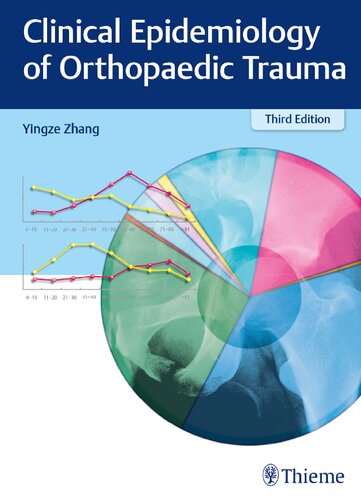Table of contents :
Clinical Epidemiology of Orthopaedic Trauma
Title Page
Copyright
Dedication
Contents
Foreword by Liming Li
Foreword by Guixing Qiu
Foreword by Robert D. D’Ambrosia
Foreword by Roy W. Sanders
Preface
Welcome to the Third Edition
Acknowledgments
Contributors
How to Use This Book
1. Introduction to Clinical Epidemiology of Orthopaedic Trauma
Fractures Overview
Fracture Classification
Bones
Segments
Types
Group and Subgroup
Epidemiological Investigation and Analysis of Traumatic Fractures Incidence in China
Methods
The Content and Method of this Investigation
Quality Control and Evaluation
Data Statistics and Analysis
Epidemiological Study of Fractures
Incidence of Sex-Specific Fractures
Fracture Location
Fractures in Children
Suggested Readings
2. Fractures of the Humerus
Overview of Humeral Fractures
Anatomic Features
AO Classification and Coding System for Humeral Fractures
Epidemiologic Features of Humeral Fractures in the China National Fracture Study
Humeral Fractures by Sex in CNFS
Humeral Fractures by Injury Side in CNFS
Humeral Fractures by Age Group and Sex in CNFS
Humeral Fractures by Location in CNFS
Humeral Fractures by Causal Mechanisms in CNFS
Clinical Epidemiologic Features of Humeral Fractures
Humeral Fractures by Sex
Humeral Fractures by Injured Side
Humeral Fractures by Age Group and Sex
Humeral Fractures by Location
Proximal Humeral Fractures (Segment 11)
Anatomic Features
AO Classification of Proximal Humeral Fractures
Clinical Epidemiological Features of Proximal Humeral Fractures (Segment 11)
Injury Mechanism
Diagnosis
Treatment
Humeral Shaft Fractures (Segment 12)
Anatomic Features
AO Classification for Humeral Shaft Fractures
Clinical Epidemiologic Features of Humeral Shaft Fractures (Segment 12)
Injury Mechanism
Diagnosis
Treatment
Distal Humeral Fractures (Segment 13)
Anatomical Features
AO Classification of Distal Humeral Fractures
Clinical Epidemiologic Features of Distal Humeral Fractures (Segment 13)
Injury Mechanism
Diagnosis
Treatment
Other Classifications of Humeral Fractures
The Neer Classification of Proximal Humeral Fractures
Classification of Humeral Fractures by Fracture Location
Clinical Epidemiologic Features of Medial Humeral Condylar Fractures
Suggested Readings
3. Fractures of the Ulna and Radius
Overview of Ulnar and Radial Fractures
Anatomic Features
AO Classification and Coding System for Fractures of Ulna and Radius
Epidemiologic Features of Radial/Ulnar Fractures in the China National Fracture Study
Clinical Epidemiologic Features of Radial/Ulnar Fractures
Proximal Radial/Ulnar Fractures (Segment 21)
Anatomic Features
AO Classification of Proximal Radial/Ulnar Fractures
Clinical Epidemiologic Features of the Proximal Radial/Ulnar Fractures (Segment 21)
Injury Mechanism
Diagnosis
Treatment
Fractures of the Radial/Ulnar Shaft (Segment 22)
Anatomic Features
AO Classification of Fractures of Radial/Ulnar Shaft
Clinical Epidemiologic Features of the Radial/Ulnar Shaft Fractures (Segment 22)
Injury Mechanism
Diagnosis
Treatment
Distal Fractures of the Radius/Ulna (Segment 23)
Anatomic Features
AO Classification of Distal Fractures of the Radius/Ulna
Clinical Epidemiologic Features of Distal Fractures of the Radius/Ulna (Segment 23)
Injury Mechanism
Diagnosis
Treatment
Other Classifications of Ulnar and Radial Fractures
Monteggia Fractures
Galeazzi Fractures
Colles Fractures
Smith Fractures
Barton Fractures
Suggested Readings
4. Fractures of the Femur
Overview of Femoral Fractures
Anatomic Features
AO Classification and Coding System for Femoral Fractures
Epidemiologic Features of Femoral Fractures in the China National Fracture Study
Clinical Epidemiologic Features of Femoral Fractures
Proximal Femoral Fractures (Segment 31)
Anatomic Features
AO Classification of the Proximal Femoral Fractures
Clinical Epidemiologic Features of the Proximal Femoral Fractures (Segment 31)
Injury Mechanism
Diagnosis
Treatment
Diaphyseal Femoral Fractures (Segment 32)
Anatomic Features
AO Classification of Diaphyseal Femoral Fractures
Clinical Epidemiologic Features of Diaphyseal Femoral Fractures (Segment 32)
Injury Mechanism
Diagnosis
Treatment
Distal Femoral Fractures (Segment 33)
Anatomic Features
AO Classification of Distal Femoral Fractures
Clinical Epidemiologic Features of the Distal Femoral Fractures (Segment 33)
Injury Mechanism
Diagnosis
Treatment
Other Classifications of Femoral Fractures
Evans’ Classification for Trochanteric Fractures of the Femur
The Garden Classification of Femoral Neck Fractures
The Pipkin Classification of Femoral Head Fractures
Suggested Readings
5. Fractures of the Tibia and Fibula
Overview of Tibial/Fibular Fractures
Anatomic Features
AO Classification and Coding System of Tibial/Fibular Fractures
Epidemiologic Features of Fractures of the Tibia and Fibula in the China National Fracture Study
Clinical Epidemiologic Features of Tibial/Fibular Fractures
Proximal Tibial Fractures (Segment 41)
Anatomic Features
AO Classification of Proximal Tibial Fractures
Clinical Epidemiologic Features of Proximal Tibial Fractures (Segment 41)
Injury Mechanism
Diagnosis
Treatment
Tibial Diaphyseal Fractures (Segment 42)
Anatomic Features
AO Classification of Tibial Diaphyseal Fractures
Clinical Epidemiologic Features of Tibial Diaphyseal Fractures (Segment 42)
Injury Mechanism
Diagnosis
Treatment
Distal Tibial Fractures (Segment 43)
Anatomical Features
AO Classification of Distal Tibial Fractures
Clinical Epidemiologic Features of Distal Tibial Fractures (Segment 43)
Injury Mechanism
Diagnosis
Treatment
Malleolar Injury (Segment 44)
Anatomical Features
AO Classification of Malleolar Injury
Clinical Epidemiologic Features of Malleolar Injury (Segment 44)
Injury Mechanism
Diagnosis
Treatment
Commonly Used Classifications for Fractures of the Tibia/Fibula
Tibial Plateau Fractures
Pilon Fractures
Suggested Readings
6. Fractures of the Spine
Overview of Spinal Fractures
Anatomic Features
AO Classification and Coding System for Spinal Fractures
Epidemiologic Features of Spinal Fractures in the China National Fracture Study
Clinical Epidemiologic Features of Fractures of the Spinal Column
Cervical Fractures (Segment 51)
Anatomic Features
AO Classification of Cervical Spinal Fractures
Clinical Epidemiologic Features of Fractures of the Upper Cervical Spine (Segment 51.01–51.02)
Clinical Epidemiologic Features of Fractures of the Lower Cervical Spine (Segment 51.03–51.07)
Injury Mechanism
Diagnosis
Treatment
Further Classification of Cervical Spine Fractures
Thoracolumbar Fractures (Segments 52 and 53)
Anatomic Features
AO Classification of Thoracolumbar Spinal Fractures
Clinical Epidemiologic Features of Fractures of the Thoracolumbar Spine (Segments 52 and 53)
Injury Mechanism
Diagnosis
Treatment
Denis Classification of Thoracolumbar Spinal Fractures
Suggested Readings
7. Fractures of the Pelvic Ring and Acetabulum
Overview of Pelvic Ring and Acetabular Fractures
Anatomical Features
AO Classification and Coding System for Fractures of the Pelvic Ring and Acetabulum
Epidemiologic Features of Pelvic and Acetabular Fractures in the China National Fracture Study
Clinical Epidemiological Features of Fractures of the Pelvic Ring and Acetabulum
Pelvic Ring Fractures (Segment 61)
Anatomical Features
AO Classification of Pelvic Ring Fractures
Clinical Epidemiological Features of Pelvic Ring Fractures (Segment 61)
Injury Mechanism
Diagnosis
Treatment
Acetabular Fractures (Segment 62)
Anatomical Features
AO Classification of Acetabular Fractures
Clinical Epidemiological Features of Acetabular Fractures (Segment 62)
Injury Mechanism
Diagnosis
Treatment
Other Classifications for Fractures of the Pelvic Ring and Acetabulum
Tile Classification of Pelvic Ring Fractures
Young–Burgess Classification of Pelvic Ring Fractures
Letournel Classification of Pelvic Ring Fractures
Special Type of Pelvic Ring Fracture: Bilateral Sacroiliac Dislocation with an Intact Anterior Pelvic Ring
Letournel–Judet Classification of Acetabular Fractures
Tile Classification of Acetabular Fractures
Suggested Readings
8. Fractures of the Hand
Overview of Hand Fractures
Anatomic Features
OTA Classification and Coding System for Hand Fractures
Epidemiologic Features of Hand Fractures in the China National Fracture Study
Clinical Epidemiologic Features of Hand Fractures
Carpal Fractures (Segments 71–76)
Anatomic Features
OTA Classification of Carpal Fractures
Clinical Epidemiologic Features of Carpal Fractures (71–76)
Injury Mechanism
Diagnosis
Treatment
Further Classification for Scaphoid Fractures
Anatomic Features and Coding System
Clinical Epidemiologic Features of Scaphoid Fractures in Adults
Injury Mechanism
Diagnosis
Treatment
Metacarpal Fractures (Segment 77)
Anatomic Features
OTA Classification of Metacarpal Fractures
Clinical Epidemiologic Features of Metacarpal Fractures in Adults (Segment 77)
Injury Mechanism
Diagnosis
Treatment
Further Classification of Base Fracture of the First Metacarpal Bone
Anatomic Features and Classification
Clinical Epidemiologic Features of Fractures of the Base of the First Metacarpal Bone
Injury Mechanism
Diagnosis
Treatment
Phalanx Fractures (Segment 78)
Anatomic Features
OTA Classification of Phalanx Fractures
Clinical Epidemiologic Features of Phalanx Fractures (Segment 78)
Injury Mechanism
Diagnosis
Treatment
Multiple Fractures (Segment 79)
OTA Classification of Multiple Fractures of the Hand
Clinical Epidemiologic Features of Multiple Fractures (Segment 79)
Suggested Readings
9. Fractures of the Foot
Overview of Foot Fractures
Anatomic Features
OTA Classification and Coding System for Foot Fractures
Epidemiologic Features of Foot Fractures in the China National Fracture Study
Clinical Epidemiologic Features of Foot Fractures
Talar Fractures (Segment 81)
Anatomic Features
OTA Classification of Talar Fractures
Clinical Epidemiologic Features of Talar Fractures
Injury Mechanism
Diagnosis
Treatment
Other Common Classifications of Talar Fractures
Calcaneal Fractures (Segment 82)
Anatomic Features
OTA Classification of Calcaneal Fractures
Clinical Epidemiologic Features of Calcaneal Fractures (Segment 82)
Injury Mechanism
Diagnosis
Treatment
Other Classifications for Calcaneal Fractures
Fractures of the Tarsal Navicular Bone (Segment 83)
Anatomic Features
OTA Classification of Tarsal Navicular Fractures
Clinical Epidemiologic Features of Tarsal Navicular (Segment 83)
Injury Mechanism
Diagnosis
Treatment
Cuboid Fractures (Segment 84)
Anatomic Features
OTA Classification of Cuboid Fractures
Clinical Epidemiologic Features of Cuboid Fractures
Injury Mechanism
Diagnosis
Treatment
Cuneiform Fractures (Segment 85)
Anatomic Features
OTA Classification of Cuneiform Fractures
Clinical Epidemiologic Features of Cuneiform Fractures (Segment 85)
Injury Mechanism
Diagnosis
Treatment
Metatarsal Fractures (Segment 87)
Anatomic Features
OTA Classification of Metatarsal Fractures
Clinical Epidemiologic Features of Metatarsal Fractures (Segment 87)
Injury Mechanism
Diagnosis
Treatment
Phalangeal Fractures (Segment 88)
Anatomic Features
OTA Classification of Phalangeal Fractures
Clinical Epidemiologic Features of Phalangeal Fractures (Segment 88)
Injury Mechanism
Diagnosis
Treatment
Multiple Fractures of the Foot (Segment 89)
Clinical Epidemiologic Features of Multiple Fractures of the Foot (Segment 89) by OTA Classification
Suggested Readings
10. Fractures of the Patella, Clavicle, and Scapula
Fractures of the Patella (Segment 34)
Anatomic Features
OTA Classification and Coding System for Patellar Fractures
Epidemiologic Features of Patellar Fractures in the China National Fracture Study
Clinical Epidemiologic Features of Patellar Fractures (Segment 34)
Injury Mechanism
Diagnosis
Treatment
Further Classifications of Patellar Fractures: The Regazzoni Classification
Clavicle Fractures (Segment 15)
Anatomic Features
Anatomic Features and Muscular Attachment of the Clavicle
OTA Classification and Coding System for Clavicle Fractures
Epidemiologic Features of Clavicle Fractures in the China National Fracture Study
Clinical Epidemiologic Features of Clavicle Fractures (Segment 15)
Injury Mechanism
Diagnosis
Treatment
Further Classifications of Clavicle Fractures
Scapular Fractures (Segment 14)
Anatomic Features
OTA Classification and Coding System for Scapular Fractures
Epidemiologic Features of Scapular Fractures in the China National Fracture Study
Epidemiologic Features of Scapular Fractures (Segment 14)
Injury Mechanism
Diagnosis
Treatment
Further Classifications of Scapular Fractures
Suggested Readings
11. Epidemiologic Features of Fractures in Taiwan Between 2011 and 2013
Introduction to the Taiwan Study
Fractures by Sex
Fractures by Age Group and Sex
Patients with Humeral Fractures
Patients with Ulnar and Radial Fractures
Patients with Femoral Fractures
Patients with Tibia and Fibula Fractures
Patients with Spinal Fractures
Patients with Fractures of the Pelvic Ring and Acetabulum
Patients with Hand Fractures
Patients with Foot Fractures
Patients with Patellar Fractures
Patients with Clavicle Fractures
Patients with Scapular Fractures
Fracture Location
Fractures in Children
Suggested Readings
Index
Occupational and Community Medicine, Emergency Medicine, Surgery
Clinical epidemiology of orthopaedic trauma
290.00EGP
+ Free Shipping


